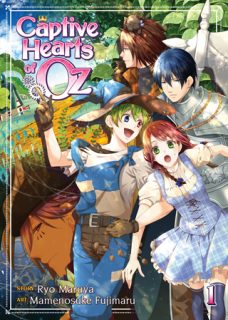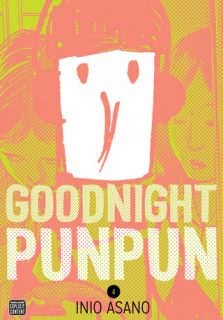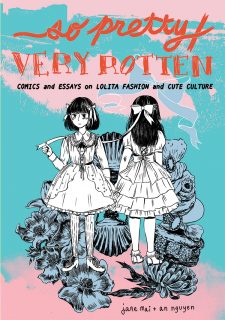My News and Reviews
The Bookshelf Overload for April was posted at Experiments in Manga last week; otherwise, things were pretty quiet. Initially I had an in-depth feature scheduled for this week, but I’ll probably end up pushing that back to next week instead. I spent last Thursday through Sunday in Canada with the family for vacation and the Toronto Comic Arts Festival (TCAF) which I’ll be writing up like I have in years past. We had a great time, although not everything went exactly as planned.
Speaking of TCAF, Heidi MacDonald, Brigid Alverson, Deb Aoki, and Erica Friedman were apparently all sharing a hotel room for the event. I haven’t had a chance to listen to it yet, but they took advantage of that fact by recording a podcast in which they (and eventually Robin Brenner and Eva Volin as well) discuss a wide variety of topics including manga, queer comics, food, libraries, and more: Episode 1, Episode 2, Episode 3, Episode 4. I only found out about the details after I got back home, but once again some people had trouble crossing the border between the United States and Canada in order to attend TCAF. In one notable case, Anne Ishii, one of the folks behind Massive and Gengoroh Tagame’s interpreter and translator, was detained for over two hours before eventually being allowed to enter the country.
A few things from elsewhere online last week: Anyone who picked up the Attack on Titan choose-your-own-path book from Kodansha Comics will want know about the corrections and errata that were recently released online. Kodansha also confirmed it would be releasing the Neo Parasyte M manga anthology (a sort of companion volume to Neo Parasyte F which I greatly enjoyed). In other licensing news, although an official public announcement hasn’t been made, The OASG received some confirmation that Udon Entertainment is currently “deep into the localization” of Rose of Versailles and Sugar Sugar Rune. No release dates have been set yet, though. Seven Seas hasn’t mentioned any release dates for its most recent set of licensing announcements, either, though I wouldn’t be surprised to see Okayado’s MaMaMa: Magical Director Mako-chan’s Magical Guidance, Mintarou’s DNA Doesn’t Tell Us, Tekka Yaguraba’s Sorry For My Familiar, Hiroaki Yoshikawa’s Crisis Girls, Tsuina Miura and Takahiro Oba’s High-Rise Invasion, and Coolkyoushinja’s Mononoke Sharing all released first.
A couple of Kickstarters that have recently caught my attention, too. Chromatic Press’ latest campaign is raising funds to print the first volume of Magical How? by Eurika Yusin Gho (aka Eyugho). Though on occasion I’ve mentioned Magical How? on Twitter, I haven’t really wrote much about the comic here at Experiments in Manga. (Or at least not yet.) It’s a pretty fun series though, a sort of magical girl/boys’ love mashup with energetic, full-color artwork and lots of humor. The other project I specifically want to mention is for the second volume of Beyond, a queer speculative fiction comics anthology. If successful, the project will also allow the award-winning first volume (which is great) to be reprinted.
Quick Takes
 Captive Hearts of Oz, Volume 1 written by Ryo Maruya, illustrated by Mamenosuke Fujimaru. One of the most interesting things about Captive Hearts of Oz is that the English-language release is actually the first time the manga has been published; rather than licensing existing content, the series is a direct collaboration between Seven Seas and the creators. Captive Hearts of Oz is Maruya’s debut work in English, but Fujimaru already has a notable presence due to the numerous Alice in the Country of… manga that have been translated. I suspect that it’s intentional then that Captive Hearts of Oz has a similar vibe to those series. Interestingly, there’s no explicit romance in the series yet although the manga is reminiscent of an otome game. Dorothy has simply been swept into an unfamiliar world where she meets a number of unusual people, many of whom just happen to be attractive young men. Captive Hearts of Oz is a somewhat unusual reimagining of a Western classic which may (or may not) have more depth to it than initially appears. At the very least there’s something dark and mysterious going on, although after only one volume it’s not entirely clear exactly what that is. The narrative is frustratingly disjointed in places, but I am curious to see how Captive Hearts of Oz continues to develop.
Captive Hearts of Oz, Volume 1 written by Ryo Maruya, illustrated by Mamenosuke Fujimaru. One of the most interesting things about Captive Hearts of Oz is that the English-language release is actually the first time the manga has been published; rather than licensing existing content, the series is a direct collaboration between Seven Seas and the creators. Captive Hearts of Oz is Maruya’s debut work in English, but Fujimaru already has a notable presence due to the numerous Alice in the Country of… manga that have been translated. I suspect that it’s intentional then that Captive Hearts of Oz has a similar vibe to those series. Interestingly, there’s no explicit romance in the series yet although the manga is reminiscent of an otome game. Dorothy has simply been swept into an unfamiliar world where she meets a number of unusual people, many of whom just happen to be attractive young men. Captive Hearts of Oz is a somewhat unusual reimagining of a Western classic which may (or may not) have more depth to it than initially appears. At the very least there’s something dark and mysterious going on, although after only one volume it’s not entirely clear exactly what that is. The narrative is frustratingly disjointed in places, but I am curious to see how Captive Hearts of Oz continues to develop.
 Goodnight Punpun, Omnibuses 4-5 by Inio Asano. At this point in Goodnight Punpun, the series’ titular protagonist has entered early adulthood and his life largely remains a directionless disaster not entirely of his own making. He’s not completely blameless, though. I find that I have to time my reading of Goodnight Punpun very carefully. The manga has a very pessimistic worldview with which I can very easily identify, so if I’m already feeling mentally or emotionally exhausted, it’s usually a good idea for me to wait to tackle the series. On the other hand, it can sometimes be extremely cathartic to completely acknowledge the unfairness and darkness of the story and its real-life parallels. Either way, Goodnight Punpun is an incredible and powerful work, but it’s also very hard-hitting. Asano seems to be very aware of this and very aware of some of the related criticisms that have been leveled at the series. I, for one, have at times questioned whether or not all of the pain and suffering in Goodnight Punpun ultimately serves a purpose or if the manga is simply reveling in gloom and despair. I’ll admit that I’m still not sure and probably won’t be convinced one way or another until the manga’s conclusion, but Asano does directly recognize those concerns by having the creative work of some of the series’ characters similarly criticized.
Goodnight Punpun, Omnibuses 4-5 by Inio Asano. At this point in Goodnight Punpun, the series’ titular protagonist has entered early adulthood and his life largely remains a directionless disaster not entirely of his own making. He’s not completely blameless, though. I find that I have to time my reading of Goodnight Punpun very carefully. The manga has a very pessimistic worldview with which I can very easily identify, so if I’m already feeling mentally or emotionally exhausted, it’s usually a good idea for me to wait to tackle the series. On the other hand, it can sometimes be extremely cathartic to completely acknowledge the unfairness and darkness of the story and its real-life parallels. Either way, Goodnight Punpun is an incredible and powerful work, but it’s also very hard-hitting. Asano seems to be very aware of this and very aware of some of the related criticisms that have been leveled at the series. I, for one, have at times questioned whether or not all of the pain and suffering in Goodnight Punpun ultimately serves a purpose or if the manga is simply reveling in gloom and despair. I’ll admit that I’m still not sure and probably won’t be convinced one way or another until the manga’s conclusion, but Asano does directly recognize those concerns by having the creative work of some of the series’ characters similarly criticized.
 So Pretty / Very Rotten: Comics and Essays on Lolita Fashion and Cute Culture by Jane Mai and An Nguyen. I don’t have a particular interest in fashion, so if it wasn’t for the fact that I make a point to follow the work of Nguyen (aka Saicoink) I might not have gotten around to reading So Pretty / Very Rotten for quite some time. That would have been a shame because So Pretty / Very Rotten is both a terrific and fascinating work. I was certainly aware of Lolita culture previously, but I can confidently say that I have a much better understanding of it and even appreciation for it after reading So Pretty / Very Rotten. The volume examines numerous topics related to Lolitas–history, culture, fashion, identity, gender, expression, community and more–through approachable and accessible essays, both personal and academic (the Lolita lifestyle is one of the areas of Nguyen’s research), as well as through comics and illustrations. It’s a mix that works quite well. The essays are informative and the comics are cute and engaging, effectively demonstrating the concepts addressed through visual narratives. So Pretty / Very Rotten also includes an interview with and essay by Novala Takemoto, a prominent figure in Lolita culture who is probably best known in North America as the creator of Kamikaze Girls.
So Pretty / Very Rotten: Comics and Essays on Lolita Fashion and Cute Culture by Jane Mai and An Nguyen. I don’t have a particular interest in fashion, so if it wasn’t for the fact that I make a point to follow the work of Nguyen (aka Saicoink) I might not have gotten around to reading So Pretty / Very Rotten for quite some time. That would have been a shame because So Pretty / Very Rotten is both a terrific and fascinating work. I was certainly aware of Lolita culture previously, but I can confidently say that I have a much better understanding of it and even appreciation for it after reading So Pretty / Very Rotten. The volume examines numerous topics related to Lolitas–history, culture, fashion, identity, gender, expression, community and more–through approachable and accessible essays, both personal and academic (the Lolita lifestyle is one of the areas of Nguyen’s research), as well as through comics and illustrations. It’s a mix that works quite well. The essays are informative and the comics are cute and engaging, effectively demonstrating the concepts addressed through visual narratives. So Pretty / Very Rotten also includes an interview with and essay by Novala Takemoto, a prominent figure in Lolita culture who is probably best known in North America as the creator of Kamikaze Girls.
 The Whipping Girl by Nuria Tamarit. I’m not entirely certain, but I believe that The Whipping Girl is the first published solo comic by Tamarit, an illustrator from Valencia, Spain. Even if it’s not, I certainly hope that there will be more in the future if for no other reason than Tamarit’s striking artwork is gorgeous. Color pencils are prominently used to illustrate The Whipping Girl and the effect is lovely. Writing-wise, the work isn’t quite as strong; The Whipping Girl feels like it ends rather abruptly, even considering that it’s a short comic to begin with, but it’s still an enjoyable tale. The story largely follows Agape, the whipping girl of Prince Dalibor. He’s a bit of a jerk, intentionally behaving improperly in order to get back at Agape who is generally much more capable than he is. She finally gets so fed up with the whole situation that she decides to make a run for it. Neither she nor Dal are able to anticipate the complete extent of the repercussions of her actions, and both are surprised to discover how close their bond really is. Overall, The Whipping Girl is a very satisfying comic with beautiful artwork, expressive characters, and a great sense of humor. Agape in particular is a delight, an intelligent, strong-willed young woman with an attitude.
The Whipping Girl by Nuria Tamarit. I’m not entirely certain, but I believe that The Whipping Girl is the first published solo comic by Tamarit, an illustrator from Valencia, Spain. Even if it’s not, I certainly hope that there will be more in the future if for no other reason than Tamarit’s striking artwork is gorgeous. Color pencils are prominently used to illustrate The Whipping Girl and the effect is lovely. Writing-wise, the work isn’t quite as strong; The Whipping Girl feels like it ends rather abruptly, even considering that it’s a short comic to begin with, but it’s still an enjoyable tale. The story largely follows Agape, the whipping girl of Prince Dalibor. He’s a bit of a jerk, intentionally behaving improperly in order to get back at Agape who is generally much more capable than he is. She finally gets so fed up with the whole situation that she decides to make a run for it. Neither she nor Dal are able to anticipate the complete extent of the repercussions of her actions, and both are surprised to discover how close their bond really is. Overall, The Whipping Girl is a very satisfying comic with beautiful artwork, expressive characters, and a great sense of humor. Agape in particular is a delight, an intelligent, strong-willed young woman with an attitude.

I just read what’s out for the manhwa webtoon Killing Stalking, and it is the most messed up yaoi I have ever read. It is so messed up it makes Ten Count look completely tame and normal by comparison. The only thing I can think of being as messed up as Killing Stalking are certain parts of Game of Thrones (like our adventures with Theon Greyjoy and Ramsay Snow in season 3 especially). But man if I somehow don’t need more Killing Stalking anyway (Boku no Pico is messed up in a different way, and in a way that I definitely did not want more of)
I’ve been meaning to give Killing Stalking a try! I know quite a few people who are following the series and my vicarious impression of it is that it is indeed incredibly messed up.